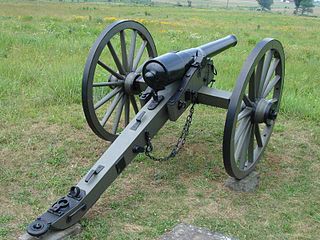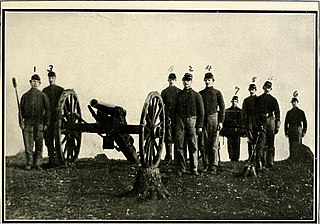
The 8th Connecticut Infantry Regiment was an infantry regiment that fought in the Union Army during the American Civil War.
Battery G, 1st Rhode Island Light Artillery Regiment was an artillery battery that served in the Union Army during the American Civil War.
The 11th Connecticut Infantry Regiment was an infantry regiment that served in the Union Army during the American Civil War.

1st Connecticut Heavy Artillery Regiment was an artillery regiment that served in the Union Army during the American Civil War.
Battery A, 1st New Jersey Light Artillery was an artillery battery that served in the Union Army during the American Civil War.
Battery G, 1st New York Light Artillery was an artillery battery that served in the Union Army during the American Civil War.
Battery "C" 5th Regiment of Artillery was a light artillery battery that served in the Union Army during the American Civil War.
Battery "I" 5th Regiment of Artillery was a light artillery battery that served in the Union Army during the American Civil War.
The 5th Maryland Volunteer Infantry Regiment was an infantry regiment that served in the Union Army during the American Civil War.

The 86th New York Infantry Regiment was an infantry regiment in the Union Army during the American Civil War.

The 103rd New York Infantry Regiment was an infantry regiment in the Union Army during the American Civil War.
Battery "B", 4th Regiment of Artillery was a light artillery battery that served in the Union Army during the American Civil War.
Battery A, 1st Pennsylvania Light Artillery was a light artillery battery that served in the Union Army as part of the Pennsylvania Reserves infantry division during the American Civil War.

Battery B, 1st New York Light Artillery was an artillery battery that served in the Union Army during the American Civil War.
The 3rd Independent Battery, New York Volunteer Light Artillery or New York Independent Light Artillery was an artillery battery that served in the Union Army during the American Civil War.
Battery "D" 5th Regiment of Artillery was a light artillery battery that served in the Union Army during the American Civil War.
Independent Battery D, Pennsylvania Light Artillery, was an artillery battery that served in the Union Army during the American Civil War. The unit organized on 21 September 1861 and served until 13 June 1865. The battery participated in the battles of Second Bull Run, Chantilly, South Mountain, Antietam, and Fredericksburg in 1862. The following year, Battery D transferred to the Western theater where it took part in the Siege of Vicksburg and other operations. The years 1864–65 saw the unit fight at the first Petersburg assault, the Crater, Ream's Station, Battle of Peebles's Farm, Fort Stedman, and the final Petersburg assault. Battery D took part in the Grand Review of the Armies before being mustered out.

The 2nd U.S. Artillery, Battery E was an artillery battery that served in the Union Army during the American Civil War. The unit fought at the battles of First Bull Run in 1861 and Yorktown, the Seven Days, Second Bull Run, Chantilly, Antietam, and Fredericksburg in 1862. The following year, Battery E moved to the Western Theater where it served at Vicksburg and Knoxville. In 1864, the unit transferred back to the Eastern Theater where it fought at the Wilderness, Spotsylvania, Totopotomoy, and Cold Harbor. For the rest of the war, it became part of the Washington D.C. garrison.

The 4th U.S. Artillery, Battery E was an artillery battery that served in the Union Army during the American Civil War. The unit fought at the battles of Kernstown, Port Republic, Rappahannock Station, Second Bull Run, Chantilly, Antietam, and Fredericksburg in 1862. The battery transferred to the Cavalry Corps where it served for the rest of the war. In 1863, 4th U.S. Artillery, Battery E fought at Chancellorsville, Gettysburg, Culpeper, Bristoe Station, and Mine Run. In 1864, the unit fought at the Wilderness, Todd's Tavern, Yellow Tavern, Totopotomoy, Cold Harbor, the Wilson-Kautz Raid, Opequon, Fisher's Hill, and Cedar Creek. In 1865, it saw action at Dinwiddie Court House, Five Forks, Sailor's Creek, and Appomattox before taking part in the Grand Review of the Armies.

The 34th Independent Battery New York Light Artillery was an artillery battery that served in the Union Army during the American Civil War. The unit was organized as Battery L, 2nd New York Heavy Artillery, but was soon detached as an independent light battery. The battery fought at Cedar Mountain, Second Bull Run, Antietam, and Fredericksburg in 1862. Battery L moved to the Western Theater where it served at Vicksburg, Jackson, and Knoxville in 1863. Now named the 34th Battery, it transferred back to the Eastern Theater where it fought at the Wilderness, Spotsylvania, North Anna, Totopotomoy, Cold Harbor, and Petersburg. The unit took part in the Appomattox campaign and the Grand Review of the Armies before being mustered out in June 1865.






